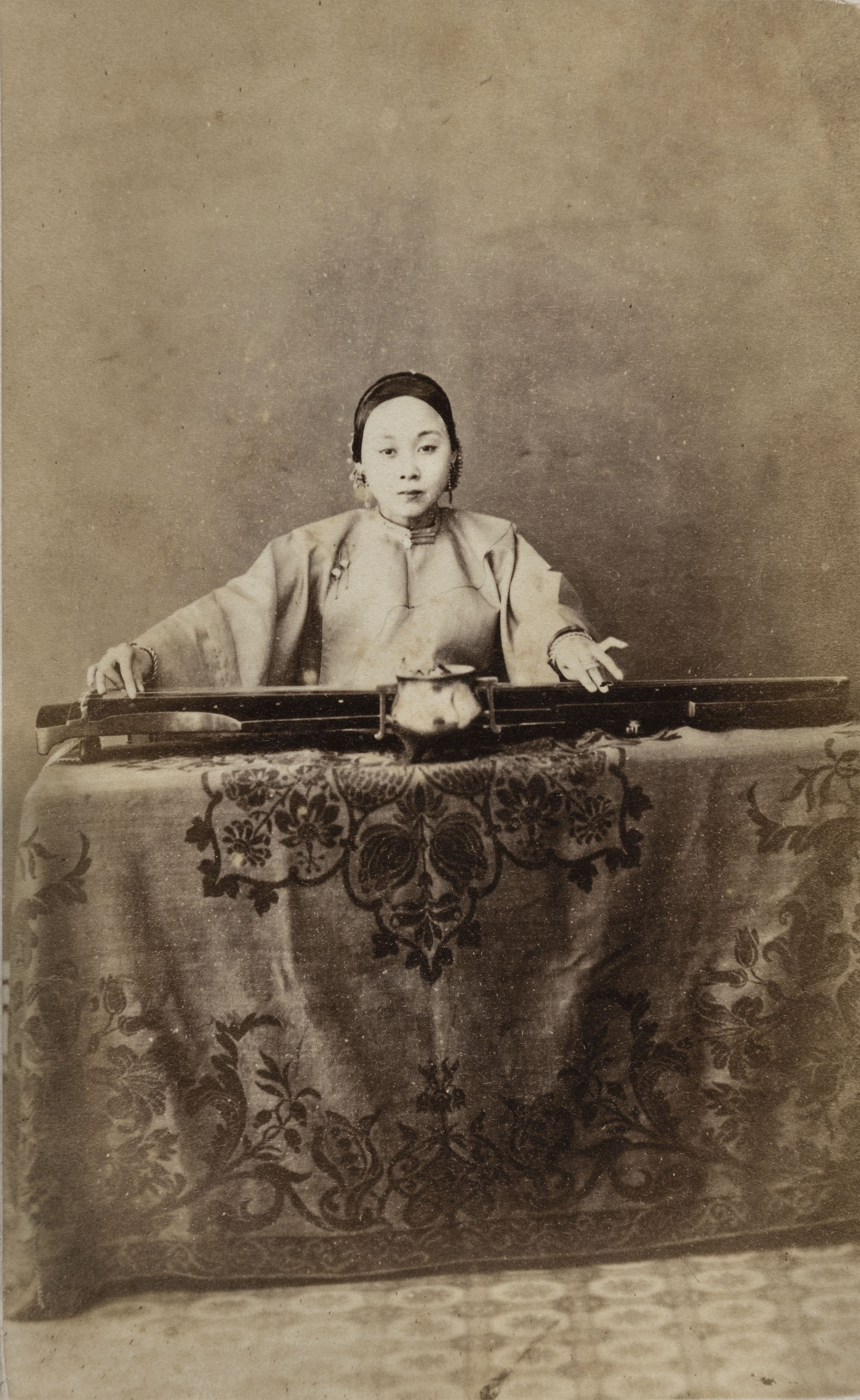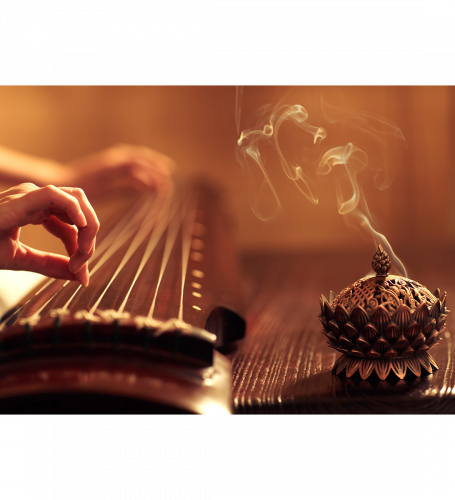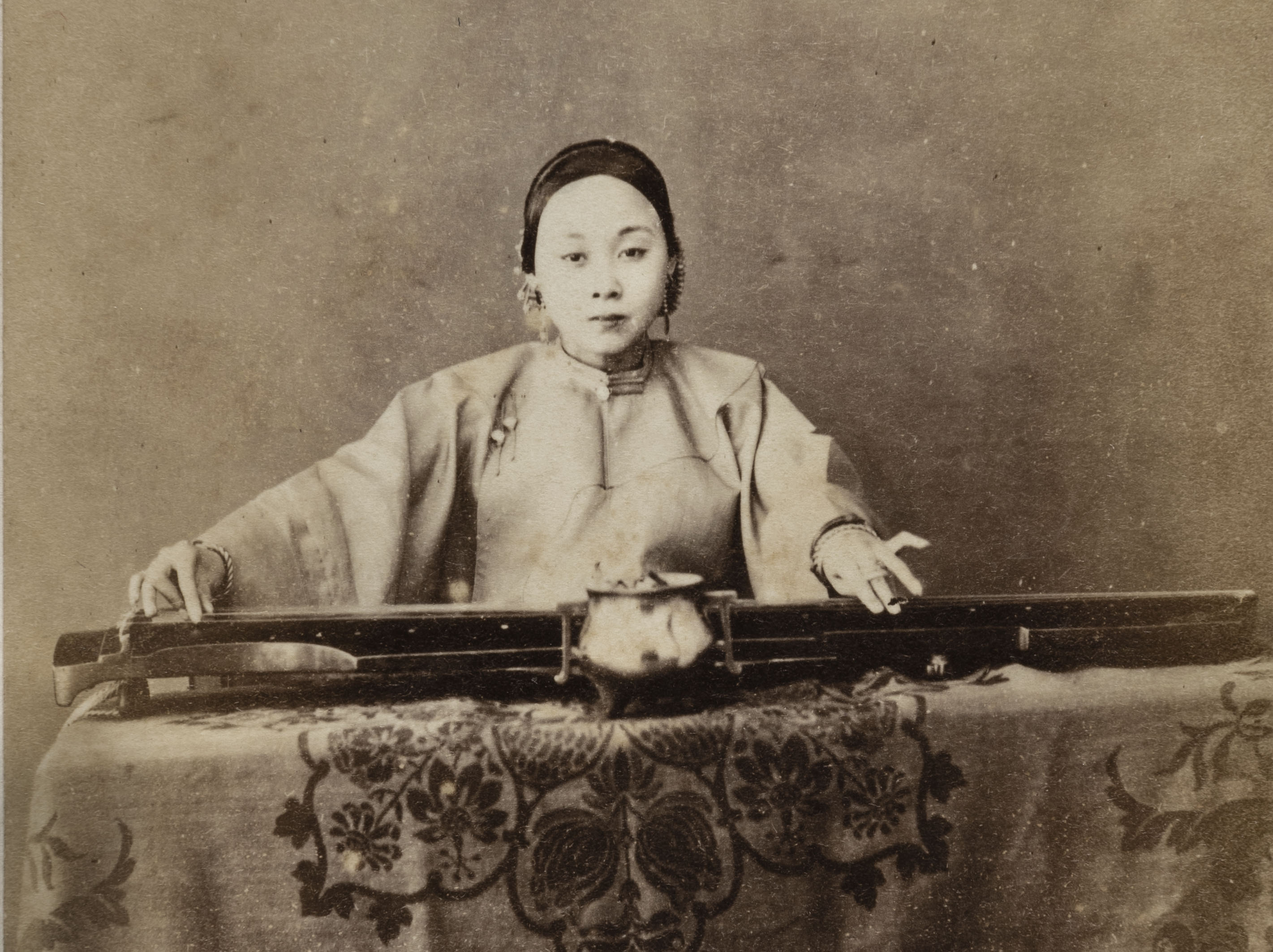

A Chan (Yazhen) Studio
1870s
Albumen silver print
11.5 x 6.5 cm
From the Loewentheil Collection
雅真影相
1870年代
蛋白印相
11.5 x 6.5 厘米
洛文希尔收藏
This rare A Chan (Yazhen) Studio photograph is one of the earliest known photographs including a guqin or qin. The instrument, the most prestigious in China, was invented more than three thousand years ago. Guqin playing developed as an elite art form practiced by scholars and noblemen. It is one of the four classic Chinese arts along with painting, an ancient form of chess, and calligraphy. The guqin is famous for being the preferred instrument of literati and sages. A Chan (Yazhen) Studio’s 1870s photographic portrait depicts a woman with a guqin, an instrument critical to Chinese intellectual history.

A Chan (Yazhen) Studio posed the elegant woman directly in front of the camera. Rather than looking down towards the musical instrument, the woman’s eyes engage the viewer as she holds her pose. In accordance with tradition an incense burner is positioned on the table in front of her. The Chinese photography studio, fully cognizant of the significance of the art form, has composed a timeless photograph of the ancient instrument and the beauty of its player.
The woman’s hand gestures suggest that she was a skilled practitioner of the instrument. Her hand positions are accurate, and her left hand is pressing the strings rather than plucking them. The constraints of early photography prevented the woman from playing the instrument while posing. Long exposure times required by the wet plate collodion process would cause motion to appear as a blur in the negative. It is very likely that the photographer instructed the guqin player to exaggerate her finger positions to emphasize her gestures and give the illusion that she was playing the instrument.
Imperial-era literature strongly suggests that guqin playing was a male dominated tradition, but paintings dating back to the Tang dynasty depict female players. The female guqin players in early paintings are identified as court ladies or ladies of refinement. Contemporary scholars believe that it is a mistaken stereotype to consider guqin playing a strictly male tradition. In order to understand the prevalence and role of female guqin players, scholars are working on closer studies of women in Ming and Qing Dynasty qin schools and societies. Today there are many more female than male qin players, and all people of all walks of life play the instrument.
Musicians in late Qing Dynasty Photography
The Guqin
The guqin is a seven stringed instrument endowed with metaphysical and cosmological significance. The instrument, beloved by sages including Confucius, is said to have the power to communicate the deepest human feelings. Writers dating back to the Han Dynasty claim that the guqin aids in cultivating character, understanding morality, and enhancing life and learning.
Each component of the guqin relates to cosmology and is identified by a zoomorphic or anthropomorphic name. The upper round board symbolizes heaven. The flat bottom board represents earth. The strings are traditionally made of twisted silk and vary in thickness. Traditionally the guqin had five strings which symbolize the five elements: metal, wood, water, fire, and earth.
Guqin playing, is much more than an auditory experience, it has an olfactory component as well. The players customarily perfumed the air by burning incense. The incense burner in A Chan (Yazhen) Studio’s portrait is placed in its usual position in front of the musician.

It is traditionally said that twenty years of training are necessary to gain proficiency on the qin. Guqin players once had a repertoire of several thousand compositions. Presently, fewer than one hundred works are still performed. Today there are fewer than one thousand well-trained guqin players and no more than fifty surviving masters. The guqin and guqin music, recognized as inseparable from Chinese intellectual history, have been added to UNESCO’s Representative List of the Intangible Cultural Heritage of Humanity.
The art form had been on the verge of extinction, but in recent times there has been a revival of guqin culture. Contemporary musicians are attracting the interest of young people in the ancient Chinese art form.
A poem written by Bai Juyi (772-846), titled 对琴待月 Waiting for the Moon with My Guqin:

In a freshly clear night in the bamboo courtyard,
I'm awake, by a window with pine trees outside.
With my longtime companion, the zither qin,
I appointed a date to rendezvous with the moon.
The jade tuning pegs have been awaiting in the wind for long.
The rippling golden moonlight, however, holds off coming out of the mist.
The elegant tones are waiting for the sky to be cloudless,
and only my inner heart knows about this.
竹院新晴夜
松窗未卧时
共琴为老伴
与月有秋期
玉轸临风久
金波出雾迟
幽音待清景
唯是我心知
For permissions and inquiries please contact:
446 Kent Avenue PH-A Brooklyn, NY 11249 USA